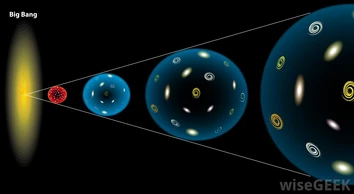
Expansion of the universe since the big bang.
The Big Bang is the theory among most scientists about how the universe was born. According to the theme song, the Big Bang was in a hot and dense state and was created around 14 billion years ago.
Timeline[]
10(-43) seconds: The universe exploded from a dense particle, traveling even faster than the speed of light. For an incredibly small fraction of a second, the universe is a hot fireball about the size of a baseball. At this point, the universe is going through a process known as "Inflation", which causes an expansion filled with matter and energy.
10(-6) seconds: Inflation has stopped, and the universe is slowing down. It is now becoming less dense, and is finally starting to cool down. Gravity is created during this time, which is collecting matter to create the first nuclei.
1 second: The universe is made up of more particles, such as electrons, photons, neutrinos, and quarks. These particles merge to create protons and neutrons.
3 seconds: The protons and neutrons merged and created the first elements, like hydrogen and helium.
10,000 years: Radiation is formed during this period. Radiation included radio waves, microwaves, infrared waves, visible light, ultraviolet rays, x-rays, and gamma rays.
300,000 years: Electrons are captured into the orbit of nuclei and are formed into stable atoms; these atoms form more complex elements. The waves in radiation are slowed down, but the universe is still expanding.
100 million years: Leftover clouds of gas and dust are collected by gravity. This causes them to clump together and draw in more gases, until it begins hot enough to stay together, creating the first stars.
300 million years: After more stars were formed, they become close enough to form an even bigger clump of gas, forming a galaxy.
Later planets, life and us.
[[Category:Sciences]
